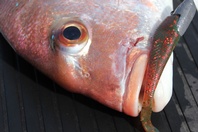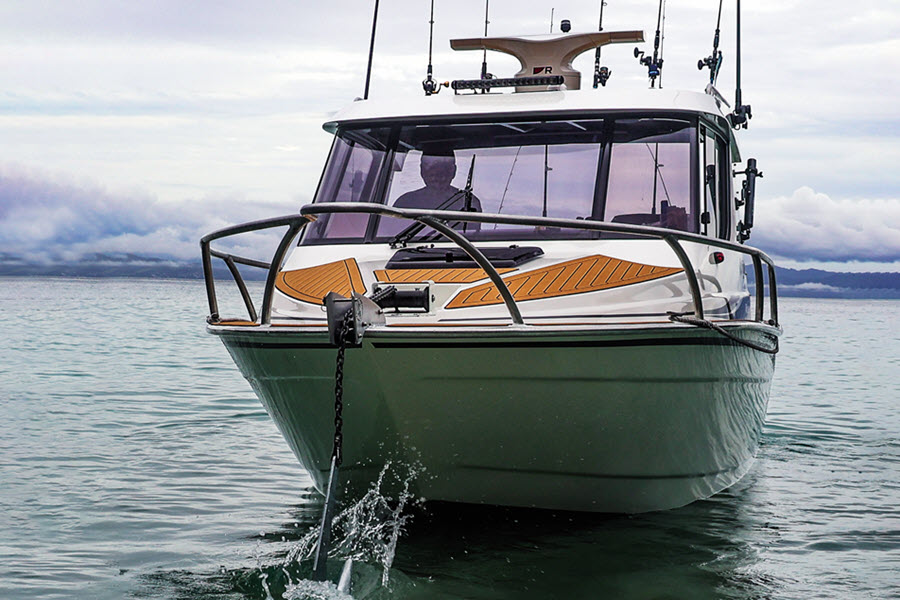Anchoring Tips: Part 1
- Nick Jones
Anchoring is a key skill for all boaters – whether you’re a fisher, an overnight adventurer, or simply like parking up in a sheltered bay to enjoy a few bevies!
Choosing your anchoring spot
There are a few considerations when deciding where to drop the pick, particularly if you’re selecting an overnight anchorage. If you’re not reef fishing, aim for a sand or mud bottom (using your sounder or eyes as a guide). Most general purpose anchors such as delta, Rocna, plough and Danforth have a good hold in softer bottom substrates, although seagrass beds may be hard for some anchors to penetrate. Grapnel anchors, on the other hand, are better suited for rocky bottoms.
The most pleasant anchorages are found where the wind is offshore. But be aware that some bays, due to the land topography, can funnel strong winds that blow out to sea – so even though the water appears flat, you might not have the best experience.
Swing room is the circumference that your boat could potentially move around within, assuming your anchor holds in the same spot. Obviously, you want enough swing room so that you will stay clear of other boats and any natural obstructions (and have enough water).
Wind direction normally determines where your vessel will sit within your swing room, but swell, current and tide changes can also have an influence in many circumstances. If you’re staying overnight, make sure to check the forecast – there’s nothing worse than having to shift spots at 2.00 am due to a wind change. Also, think about the stage of the tidal cycle when calculating your depth requirements – it’s no use anchoring in 3m of water at high tide for an overnight stay when there’s a 3.5m tidal range!
Dropping the pick
Once you’re confident you’ve found your spot and your ground tackle is up to the task, it’s time to drop the pick. You’ll want your boat stationary and bow into the wind before you let your anchor out. If anchoring by hand, let the chain out steadily rather than simply throwing the gear overboard.
If you’re lucky enough to have a capstan or drum winch controlled from the helm (such as the Vetus- Maxwell Tasman 8 on our Fishing News Extreme 745 Gameking), keep an eye on how much chain you’re letting out. Many boaters put markers on their chain if they don’t have an electronic counter. Different coloured robust cable ties placed on the chain and the warp are a common way of indicating rode (rope) length.
It is a good idea to do this on your chain a metre or so from the ground tackle so you can slow the retrieve in time to snub the anchor without it swinging around at the bow roller, potentially damaging the hull. As you lower the anchor, your boat should begin to drift backward with the wind or current, allowing the anchor to move down and away as it enters the water. If your boat is stationary when the
anchor touches down, the chain piling on top of it can prevent it from digging in.
Therefore, if your boat is not drifting backward on its own, put the engine in reverse and move slowly backwards as you pay out the rode. Keep tension on the anchor rode as you pay it out. This ensures that your anchor, chain, and rope stay straight and don’t become tangled.
If you’re anchoring in strong winds, you may actually have to put the engine in forward gear to control the speed and direction of the backward drift. Once the ground tackle is resting correctly on the bottom, it’s time to set the anchor.
Ensuring the anchor is set
Scope is defined as a ratio of the length of an anchor line from the bow to the anchor shackle and the depth of the water under the bow of the boat measured from deck height. Most anchoring texts and anchor manufacturers agree that a scope of 7:1 achieves the anchor’s designed holding power, and more scope is better than less. In theory, 7:1 scope is great, but at a crowded anchorage in good conditions, most would sneer at the idea of paying out anywhere near this much rode; there simply wouldn’t be enough space for boats to swing.
A safe rule of thumb for the quantity of line to scope depends on whether you are using a rope/ chain combination or a full chain line. For chains, three times the depth of water is usually ample (3:1 scope), but for rope/chain combination lines, a bit more scope is preferred. To ensure that an anchor sets well, apply power in reverse to tension the rode, so the anchor penetrates the bottom. To be sure the anchor is set, you must put a reasonable strain on the rode for a reasonable length of time. If your boat moves, reset the anchor and try again.
Staying safe
Traditionally, mariners used transits (landmarks or other anchored boats) to determine if the anchor was set. Nowadays, they can be used in conjunction with chartplotters. Remember, you may move around a bit within your swing room, and this doesn’t necessarily mean you’re drifting.
If you’re anchoring at night, don’t forget your anchor lights to let other boats know where you are. Setting the anchor alarm on your chartplotter or proximity alarm on your radar will give you peace of mind, although often the noise of a wind shift or dragging anchor will rouse you from your slumber anyway!
On full chain rodes, the use of a snubber rope can improve your overnight experience. A snubber is a short length of rope (typically nylon as it has a bit of stretch) attached between the anchor chain and one or two bow cleats, employed to take the load off the windlass and stop the chain rattling on the bow roller.

December 2022 - Nick Jones
New Zealand Fishing News Magazine.
Copyright: NZ Fishing Media Ltd.
Re-publishing elsewhere is prohibited
Recent Posts Visit Forum

What I Bought Today
in T.A.S (Tackle Acquisition Syndrome)1 hour ago
Pcj
Boy wanted a cam belt,tensionor ,water pump etc for a toyota camry 1997,quoted nz $800 did the whole job for $180.Parts arrived from Mace Engineering Aussie...
POPPING VANUATU
in Popper and Topwater Fishing5 hours ago
jakepitsville
we will be fishing on dropcast but would most def prefer to bring my own gear. The new Gosa appears to have a fantastic review from...

Anyone get out today??
in Landbased & Surfcasting6 hours ago
smudge
What was the bait you were using?...

Manukau Harbour & West Coast fishing
in Fishing Reports18 hours ago
smudge
That's a decent catch.. Perseverance!...
FOR SALE: PAKULA GAME FISHING LURES RIGGED
in Buy Sell Trade or Exchange19 hours ago
MB
Very good condition. Lures supplied with Pakula double hook rig and 300lb leader. Hardly used, hooks still sharp. Both lures for $140. Pickup Whangarei CBD or...
Popular Articles

Softbait Fishing - Part 1 - gear selection
John Eichlesheim writes an article about selecting the right equipment for softbait fishing... Read More >

Softbait fishing Pt 2 - tips and tricks
Techniques, tips and tricks of softbait fishing – getting the most from your soft baits.... Read More >

Surfcasting - setting yourself up
Gary Kemsley helps sort out the necessary gear for intending surf fishers.... Read More >

Squid - How to catch them
Squid fishing is a rapidly growing aspect of fishing - Paul Senior shares some hints and tips to get started.... Read More >
Fishing Reports Visit Reports
Canterbury Fishing Report - 04/04/24
Fish galore! Coming off the back of Easter Weekend and with some very nice weather... Read More >
Raglan Fishing Report - 04/04/24
Excellent snapper action There is some excellent autumn snapper fishing straight out and up the... Read More >
Bream Bay Fishing Report - 04/04/24
Whangarei Harbour fishing well Like the weather, the fishing has been patchy throughout Bream Bay... Read More >
Hauraki Gulf Fishing Report - 04/04/24
Party time! Inshore fishing and offshore fishing are on now. It’s that perfect time of... Read More >

Comments